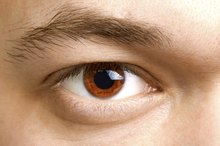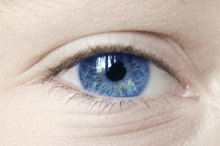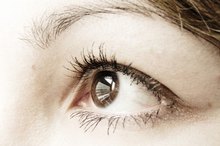What Causes a Kaleidescope Halo in the Eye?
Halo vision is more common than kaleidoscope vision when it comes to abnormal eye problems but they can both combine to produce dramatic visual distortions. Halo or rainbow vision involves seeing auras, halos or rings around objects. Kaleidoscope vision involves “fractal” sight: a splintering or shattering of images into parts the person must struggle to assemble, in order to make sense of what they’re seeing. There are many possible causes for kaleidoscope vision and halo vision.
Corneal Edema
Corneal edema refers to a swelling of the cornea, the clear lens of the eye. Fluid builds within the cornea so that light is refracted incorrectly. This can result in kaleidoscope vision or rainbow vision. The Swiss eye clinic Perret Opticiens reports that there are many possible causes of corneal edema 23. These include acute glaucoma, cataract surgery, contact lens overuse, Fuch’s endothelial dystrophy and eye trauma.
- Corneal edema refers to a swelling of the cornea, the clear lens of the eye.
- These include acute glaucoma, cataract surgery, contact lens overuse, Fuch’s endothelial dystrophy and eye trauma.
LASIK Eye Surgery
What Eye Problems are Typical With Crohn's Disease?
Learn More
Kaleidoscope vision and halo vision may also occur after LASIK eye surgery. Certain conditions, such as diabetes or dry eyes, can affect how well you heal according to the website All About Vision. LASIK surgery involves cutting a thin corneal flap to re-shape the eye. Problems with how thick or thin this cut is or how it re-adheres can cause vision distortions such as kaleidoscope vision or halos.
Read more about nearsightedness vs. farsightedness.
- Kaleidoscope vision and halo vision may also occur after LASIK eye surgery.
- Problems with how thick or thin this cut is or how it re-adheres can cause vision distortions such as kaleidoscope vision or halos.
Ocular Migraines
Migraine headaches commonly cause people to see auras or halos and can cause kaleidoscope vision as well. Not everyone who experiences kaleidoscope vision or halos gets a migraine afterwards, reports Perret Opticiens 23. Blind spots, lightning-like flashes, shimmering and traveling colors and fragmented vision are all symptoms of ocular or ophthalmic migraines 2.
Read more about the causes of eye migraines.
Posterior Vitreous Detachment
What Causes Eye Floaters in Vision?
Learn More
Aging causes the vitreous gel of the eye to shrink and pull away from the back wall of the eye. This can lead to posterior vitreous detachment and vision distortions such as halo vision or kaleidoscope sight, according to Edina Eye Clinic in Minnesota.
Posterior vitreous detachment can lead to a more serious condition: retinal detachment. As the vitreous pulls away from the back wall; it tugs on the retina and optic nerve, reports Perret Opticiens 23. These tugs can produce flashes of light or leave debris suspended in the vitreous. These floaters can create patterns like cobwebs or nets across the visual field. These same symptoms can be seen if the retina detaches or tears due to trauma or vitreous detachment. Retinal detachment can lead to blindness.
- Aging causes the vitreous gel of the eye to shrink and pull away from the back wall of the eye.
- This can lead to posterior vitreous detachment and vision distortions such as halo vision or kaleidoscope sight, according to Edina Eye Clinic in Minnesota.
Uveitis
A number of conditions, collectively referred to as uveitis, can cause inflammation of the eye and distorted vision.
Related Articles
References
Writer Bio
Sumei FitzGerald has been writing professionally since 2008 on health, nutrition, medicine and science topics. She has published work on doctors' websites such as Colon Cancer Resource, psychology sites such as Webpsykologen and environmental websites such as Supergreenme. She holds a Bachelor of Arts in sociology from the University of Connecticut where she also studied life sciences.








